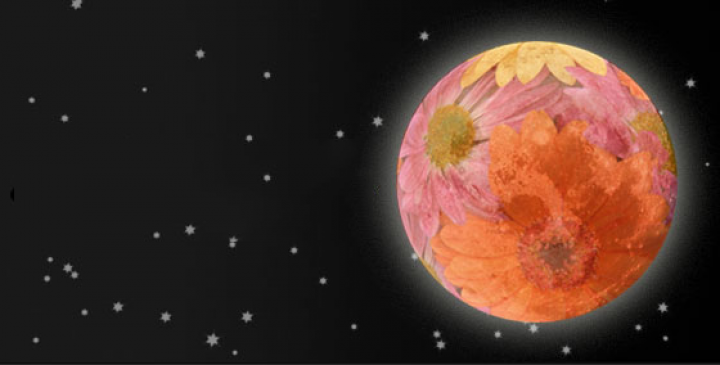May’s full Moon reaches its peak on May 5, 2023!
Full Moon May 2023: 7 Things To Know About The ‘Flower Moon Eclipse’—The Deepest Until 2042
This week sees the rise of May’s full Moon—known as the “Flower Moon”—which will be a beautiful astronomical event to witness in itself. However, for some parts of the world the Moon will be eclipsed by the Earth.
Here are seven things you need to know about the “Flower Moon” and its penumbral lunar eclipse:
1. Only some of the world will see it eclipsed by Earth
North America sits this one out. Parts of Europe and all of Africa, Asia, Australia and parts of the Pacific will be able to see the Moon will be eclipsed by the Earth. It’s called penumbral lunar eclipse and it’s happening because the full “Flower Moon” will drift into Earth’s fuzzy outer shadow for a few hours. Here’s an interactive Google Map from eclipse cartographer Xavier Jubier.
2. No ‘Blood Moon,’ but a very deep penumbral eclipse
A total lunar eclipse is when the Moon moves through Earth’s dark central umbral shadow in space. That’s not what is happening this week. Instead, it will pass only through Earth’s penumbra, its outer, fuzzy shadow. It’s a question of alignment—a penumbral lunar eclipse occurs when the Sun, Earth and the full Moon are almost, but not quite, aligned with each other.
However, this eclipse has a penumbral magnitude to 0.964—making its the deepest penumbral eclipse until Sept. 29, 2042, according to Timeanddate.com. The explanation is that the Moon will only just miss moving through the Earth’s umbra – its darker, central shadow. So it’s almost a partial lunar eclipse.
3. The entire world will see it at its best on Friday
The effect of a penumbral lunar eclipse is to make the Moon appear dimmer. It can be an interesting thing to observe, but arguably a much more beautiful sight is to see the “Flower Moon” appear on the eastern horizon at moonrise where you are. It will look a beautiful muted orange for about 15 minutes as its ries, eventually turning yellowy, then a very bright grey.
4. It will look orange as it rises and sets
A full Moon looks orange as it rises and sets. Why? Visible light is a form of electromagnetic radiation, which is made-up of photons—particles of light—that travel in different wavelengths. Rayleigh scattering—the deflection of light off molecules of nitrogen and oxygen in the Earth’s atmosphere—explains that while short-wavelength light, such as blue, strikes molecules in Earth’s atmosphere and gets scattered, longer wavelength light, such as red and orange, more easily travel through Earth’s atmosphere to reach your eyes. It’s the same for a sunrise and sunset.
5. ‘Shooting stars’ may be visible
The Eta Aquarid meteor shower peaks on the same night as the rise of the “Flower Moon.” That’s not good news for anyone wanting to see “shooting stars” per se, but the Eta Aquarids are known for producing some very bright meteors. It’s something of a longshot, but during the night—particularly from areas that will see a penumbral lunar eclipse—some “shooting stars” may be visible.
6. The eclipse is a direct result of the recent total solar eclipse
Ongoing right now is an “eclipse season” containing two eclipses—one of the Sun by a New Moon and one of the Full Moon by the Earth. The former —a total solar eclipse—occured on April 20, 2023 with spectacular results as seen from the southern hemisphere. The Moon was in exactly the right place to intersect the Sun’s path through the sky . Two weeks later, just like clockwork, it’s in the right place to align with Earth and Sun once again, but this time, Earth is between Sun and Moon. The result is a lunar eclipse.
7. The next ‘Blood Moon’ isn’t until 2025
We’re in a dry spell for total lunar eclipses, with the next one not occurring until March 13-14, 2025. This time North America (as well as visible from South America and the Pacific) will be on the night-side of Earth at the right time, though visibility might be an issue in March. Totality will last 65 minutes.
Wishing you clear skies and wide eyes.
I'm an experienced science, travel and photography journalist and stargazer writing about exploring the night sky, total solar eclipses,
...Here’s everything you should know about this month’s full Moon, including how it came to be called the “Flower Moon.”
When to See the Full Moon in May 2023
May’s full Flower Moon reaches peak illumination at 1:36 P.M. (EDT) on Friday, May 5. It will be below the horizon at this time, so plan to venture outdoors on the nights of the 4th and the 5th to get the best view of the bright full Flower Moon! Find a location with unobstructed views of the horizon, if possible. See what time the moon will be visible in your area with our Moonrise and Moonset Calculator.
Why Is It Called the Flower Moon?
The full moon names used by The Old Farmer’s Almanac come from a number of places, including Native American, Colonial American, and European sources. Traditionally, each full Moon name was applied to the entire lunar month in which it occurred, not solely to the full Moon.
The Flower Moon
May’s Flower Moon name should be no surprise; flowers spring forth across North America in abundance this month!
- “Flower Moon” has been attributed to Algonquin peoples, as confirmed by Christina Ruddy of The Algonquin Way Cultural Centre in Pikwakanagan, Ontario.
- May’s Moon was also referred to as the “Month of Flowers” by Jonathan Carver in his 1798 publication, Travels Through the Interior Parts of North America: 1766, 1767, 1768 (pp. 250-252), as a likely Dakota name. Carver stayed with the Naudowessie (Dakota) over a period of time; his expedition covered the Great Lakes region, including Wisconsin and Minnesota areas.
- Henry David Thoreau sparked the Native American Moon names as well, referencing the Flower Moon and Carver when he wrote about Native Americans.

Alternative May Moon Names
May’s Moon names tend to speak to the arrival of spring and all that it entails!
The Cree names Budding Moon and Leaf Budding Moon celebrate the awakening of local flora, which really begin to leaf out now in many areas. Similarly, Planting Moon (Dakota, Lakota) marks the time when seeds should be started for the farming season ahead.
The activities of animals marked spring’s arrival, too, which is highlighted by the Cree names Egg Laying Moon and Frog Moon, as well as the Oglala term Moon of the Shedding Ponies. All three names indicate that warmer weather is on the way!
→ See all 12 months of full Moon names and meanings.
Moon Phases for May 2023
All dates and times are EDT. See our Moon Phase Calendar for times in your location.
| Full Moon: May 5, 1:36 P.M. EDT | |
| Last Quarter: May 12, 10:29 A.M. EDT | |
| New Moon: May 19, 11:55 A.M. EDT | |
| First Quarter: May 27, 11:23 A.M. EDT |
→ When is the next full Moon? Find out in our Full Moon Dates chart.








No comments:
Post a Comment